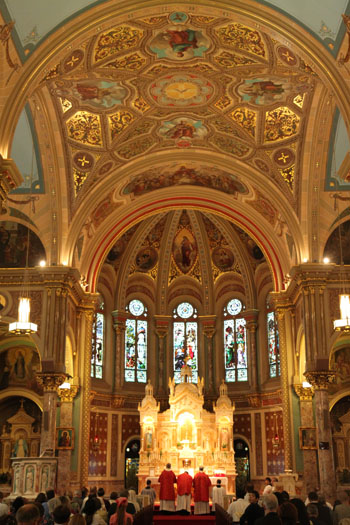Formation for the Extraordinary Form
http://www.zenit.org/article-27609?l=english
A lack of priests trained to celebrate Mass in the extraordinary form was a common concern after the Pope issued “motu proprio” [on his own initiative] his apostolic letter “Summorum Pontificum” in 2007. The papal document aimed to make it easier to celebrate the old Mass, but a lack of qualified priests was sometimes used as a reason not to allow it to be celebrated in certain dioceses.
But thanks to the traditionalist Priestly Fraternity of St. Peter (FSSP) and Una Voce USA, an international federation promoting the Tridentine Mass, it has co-produced a successful program to fill the gap. The FSSP priests have teamed up with the traditionalist group to help train other clergy on how to celebrate Mass in the extraordinary form across the United States.
Since it began in 2007, 130 priests have been trained through the program, and a highly acclaimed CD has been produced in collaboration with EWTN to help them learn more about how to celebrate the old rite. FSSP priests are sent to any diocese where a “stable group” of faithful has requested Mass in the old rite. “The results have been amazing,” says Jason King, a director of Una Voce USA who thought up the idea of working with the FSSP on the project. “It’s been such a blessing to be involved in it and to help others have the ability to attend Mass in the extraordinary form whenever they like.”
King, who is also second vice president of the International Federation of Una Voce, was in Rome for the organization’s annual meeting. In a report on the second anniversary of Summorum Pontificum, Una Voce noted that since September last year, there has been a “noticeable improvement” in awareness of the motu proprio in Poland, South Africa, and the United States. In the U.S., traditional Masses are now being celebrated in 151 of the nation’s 178 dioceses.
But it also reported that in most other places, the situation remains “unchanged” with resistance among some bishops to the old rite, and even threats against some priests who wish to celebrate it. In Italy, Germany, Austria, Switzerland, France, England and Wales, there has been “some increase in Masses and locations”, but it added that this is “often due to the persistence of lay people and the courage of individual priests rather than the pastoral concern of their bishops.”
Michael Dunnigan, chairman of Una Voce USA, said the resistance isn’t always so obvious: Some bishops or chanceries, for example, are telling groups who request a Mass in the extraordinary form that they have to find a priest themselves to celebrate it. “I don’t think it’s right to put that burden on the laity,” he says. Help from the FSSP priests is reducing the number of these cases, says Dunnigan, but some chanceries are even opposed to them visiting their dioceses to train other priests.
One other weakness since the Holy Father released the motu proprio has been a lack of back-up from Rome. Summorum Pontificum stated that, should there be resistance to requests, appeals could be made, but the Ecclesia Dei Commission at the Vatican has not been offering much in the way of support, according to some who favour the old rite.
But overall, supporters of the old Mass are still delighted with the results of the motu proprio so far. Una Voce were particularly grateful that they could have a public, solemn High Mass celebrated in St. Peter’s basilica last weekend – only the second of the past 40 years (the first was celebrated last month by Archbishop Raymond Burke). Significantly, the Mass took place in the St. Pius X chapel, after being moved at the last minute from the nearby chapel of St. Joseph.
“The best part was the spontaneous singing that occurred, which filled the basilica with wonderful Latin hymns,” says King. “I wasn’t looking, but I heard later that so many people were stopping and looking in wonderment at the liturgy that was taking place.”
* * *
Edward Pentin is a freelance writer living in Rome. He can be reached at: epentin@zenit.org.


